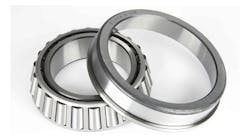Edited By Charles Bates
Phillips Service Industries barcodes and tracks components to be repaired so that customers can be updated as to job status at any time.
A control board or motor in an assembly line robot malfunctions, and the shop manager must take action. But first, he or she must decide whether to replace or repair. The decision may seem like a no-brainer, especially in today’s economy. However, industry experts point out that many companies that rely on electronic, hydraulic and precision mechanical components often needlessly replace expensive parts because they are in the dark about OEM warranty details. Or they simply don’t take the time to consider the advantage of repair.
The repair choice means lower costs, reduced inventory and a “green” environmental dividend. A repair’s carbon footprint is tiny as compared with that of making a new part.
In the auto industry, many plant managers have realized the benefits of choosing to repair over replacement. These managers know that when a pilot valve breaks down, for instance, replacing it will cost around $6,165. Yet, outsourcing the repairs to a qualified firm gets the valve repaired and possibly made better than new at a cost of about $760, a mere 12 percent of the price of a new unit.
The cost to replace a broken spindle motor in that same automotive plant may cost around $18,000. The price to repair it falls just under $5,000, or 73 percent less than a new one.
Manufacturers achieve significant savings by contracting with expert repair firms, such as PSI Repair Services.
Savings aren’t merely a result of lower repair costs. Many plant managers have indicated that their assembly lines run more efficiently thanks to repair firms such as PSI Repair Services Inc. of Livonia, Mich. That firm goes so far as to assign an in-house account representative to a customer’s site, and this representative is not there to sell services. Instead, due to the enormous volume and range of the contractor’s repair experience — electronics, process instrumentation, hydraulics, motors, ballscrews and more — the representative is on site to monitor repair needs and identify flaws in production lines.
When problems arise, the firm alerts the clients to the specific weakness and offers a permanent cost-saving solution. Operating costs drop when equipment performance improves.
According to Bob Phillips, vice president at PSI Repair Services, overall efficiency of a manufacturing plant is an outcome that should be taken seriously. He said it not only saves money, but also helps reduce global pollution.
“When you look at what it takes to manufacture a new robot, you’ve got to realize companies from all over the world are contributing elements to the project, and each is putting out some kind of pollutant,” said Phillips. “Yet, if we are repairing a robot, the carbon footprint is virtually nil. We don’t want to just fix things. We’d like to help fix the planet.”
Solving engineering problems and manufacturing issues is also a “green” endeavor. For example, an assembly line at a local company was continually going down and operating at only 65 percent capacity. By taking a ‘big picture’ approach — not just repairing one malfunctioning part — PSI Repair Services was able to raise productivity to 90 percent. Efficient plants use less energy.
The repair company also offers a website, www.psirepair.com, where customers can purchase repairs online, ask questions, get real-time answers, and generally reduce paper flow.
Plant managers know that the cost of doing business means timely purchases of new equipment and parts. On the other hand, to keep the factory running full time, managers must respond to endless equipment requests from assembly line workers: Should they replace or repair? Under these circumstances, tracking and enforcing warranties from a wide variety of OEMs is virtually impossible.
To make matters worse, some OEMs downplay warranties and try to convince clients that it is easier to buy new components. It has also been reported that some OEMs may replace a broken part with a new unit and tell the client it was repaired — then invoice for the new and more expensive part.
In these situations, shops can get help coordinating all warranty data with an on-site repair account representative. When a breakdown occurs, the manager notifies the representative, who then weighs the replace-versusrepair issue by tracking the part’s warranty information, all of which should be available in a company’s database.
The representative gleans details of the warranty agreement, which makes it possible to identify “repeat offenders.” That is, parts that have a history of malfunction and may be the root-cause of a larger problem. Such insights all add to keeping factories running efficiently.
When the decision is made to repair, parts get transferred to PSI Repair Services’ facility, one that operates entirely under lean manufacturing principles and is ISO 9001 and 9002 certified. The company barcodes and tracks each part through the entire process so that a customer can be updated on job status at any time.
Phillips, who touts his firm as the largest industrial repair company in the world, takes pride in reducing processes to an absolute minimum of movement, with no wasted energy or time. And, depending on the part being repaired, the company offers a 12-month warranty on the work, again, because quite often the repaired part is made stronger than the original.
If a valve, motor or other electronic, hydraulic or precision mechanical component cannot be fixed, PSI Repair Services delivers a frank assessment to the customer; it doesn’t just try to sell them something. Instead, the firm strives to earn the trust of its customers, not just their business.
Information for this article provided by Phillips Service Industries.






